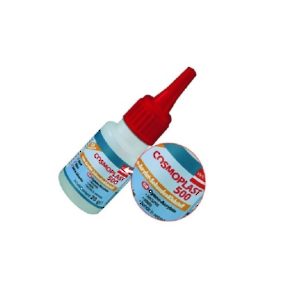Technical data sheet
Cosmoplast Adhesive 500
Product # SA4360
For Rubber & EPDM Gaskets
To achieve a durable resistance to penetration of rain, we recommend additional bonding of the section corner on the glass pane using neoprene rubber filler or sealing compound for bonding the external glass strip seals in window construction. Can also used for vehicles, household aplliance production, metal construction, exhibition stand construction, etc.
Pressing times greatly depend on material and adhesive temperature.
Pressing times greatly depend on material and adhesive temperature.
ADVANTAGES AND BENEFITS
* Locks
* Bonds within seconds
* Short time to reach functional strength for assembly works
* Good adhesion characteristics to different surfaces
* Solvent-free
* Good wetting of the substrate
* Hard adhesive joint
* Extremely short fixing times
* Very high strength
* Good UV stability
* Highly resistant to frost and heat
* Bonds within seconds
* Short time to reach functional strength for assembly works
* Good adhesion characteristics to different surfaces
* Solvent-free
* Good wetting of the substrate
* Hard adhesive joint
* Extremely short fixing times
* Very high strength
* Good UV stability
* Highly resistant to frost and heat
TECHNICAL SPECIFICATIONS
Product #
SA4360
Weight
20 g
Finish/Color
Clear Transparent
Viscosity
20 mPa.s
Material
Cyanoacrylate
Drying time (approx.)
16 hours
APPLICATION
- Apply the adhesive from the trading unit or by means of a CA-dosing unit onto one side.
- Immediately after application, the workpieces must be fit together and pressed until they reach the required functional strength.
EPDM/EPDM - profile sealing approx. 4 s
PVC rigid/PVC rigid from 8 s
- Immediately after application, the workpieces must be fit together and pressed until they reach the required functional strength.
EPDM/EPDM - profile sealing approx. 4 s
PVC rigid/PVC rigid from 8 s
IMPORTANT INFORMATION
- Gap bridging Max. 0.1 mm (3.9 mil)
- If silicon, TPE sections and polyolefins are bonded, they are to be pretreated with primer. The variety of materials requires that you carry out some preliminary tests yourself.
-Bonding of aluminium, copper, brass: only on chemically pretreated or varnished surfaces; these materials cannot be durably bonded to be age-resistant without appropriate pre-treatment of the surfaces to be glued.
- Open time, as well as the necessary pressing time, can only be determined accurately by self-tests because they are strongly influenced by material characteristics, temperature, applied quantity, air humidity, material humidity, thickness
of adhesive film, press power, and other criterions. Usually, appropriate safety factors are considered for the guiding values.
- If silicon, TPE sections and polyolefins are bonded, they are to be pretreated with primer. The variety of materials requires that you carry out some preliminary tests yourself.
-Bonding of aluminium, copper, brass: only on chemically pretreated or varnished surfaces; these materials cannot be durably bonded to be age-resistant without appropriate pre-treatment of the surfaces to be glued.
- Open time, as well as the necessary pressing time, can only be determined accurately by self-tests because they are strongly influenced by material characteristics, temperature, applied quantity, air humidity, material humidity, thickness
of adhesive film, press power, and other criterions. Usually, appropriate safety factors are considered for the guiding values.
DISCLAIMER
- Curing time at +20 °C (+68 °F), 50% r. H. approx. 16 h
- Softening range from +80 °C (+176 °F)
- The chemical characteristics of the surfaces to be glued variations of raw material characteristics, surface coatings, as well as corrosion and contamination have a significant effect on the desired bonding strength.
- Follow the corresponding technical data sheets for the recommended products mentioned above.
-Viscosity; measured by cone and plate (3 000 s-1) at +25 °F (+77 °F) approx. 20 mPa.s (20 cP)
-Density; as per EN 542 at +20 °C (+68 °F) approx. 1.05 g/cm³ (8.76 lb/gal)
- Softening range from +80 °C (+176 °F)
- The chemical characteristics of the surfaces to be glued variations of raw material characteristics, surface coatings, as well as corrosion and contamination have a significant effect on the desired bonding strength.
- Follow the corresponding technical data sheets for the recommended products mentioned above.
-Viscosity; measured by cone and plate (3 000 s-1) at +25 °F (+77 °F) approx. 20 mPa.s (20 cP)
-Density; as per EN 542 at +20 °C (+68 °F) approx. 1.05 g/cm³ (8.76 lb/gal)




